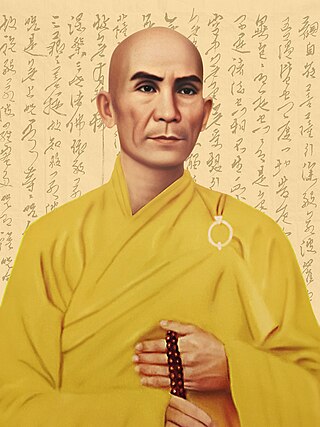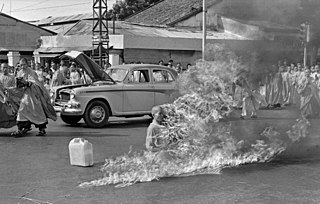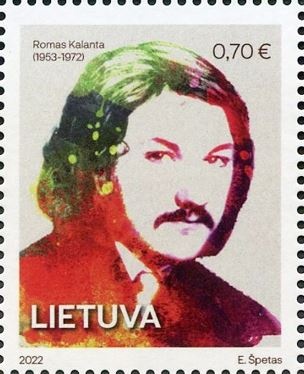
Roger Allen LaPorte was a protester of the Vietnam War who set himself on fire in front of the United Nations building in New York City on November 9, 1965, to protest the United States involvement in the war. A former seminarian, he was a member of the Catholic Worker Movement at the time of his death.

Jan Palach was a Czech student of history and political economics at Charles University in Prague. His self-immolation in 1969 at age 20 was a political protest against the end of the Prague Spring resulting from the Warsaw Pact invasion of Czechoslovakia in 1968 by the Warsaw Pact armies.

Thích Quảng Đức was a Vietnamese Mahayana Buddhist monk who died by self-immolation at a busy Saigon road intersection on 11 June 1963. Quảng Đức was protesting against the persecution of Buddhists by the South Vietnamese government of Ngô Đình Diệm, a staunch Roman Catholic. Photographs of his self-immolation circulated around the world, drawing attention to the policies of the Diệm government. John F. Kennedy said of one photograph, "No news picture in history has generated so much emotion around the world as that one." Malcolm Browne won the World Press Photo of the Year for his photograph of the monk's death.

Self-immolation is the act of setting oneself on fire. It is mostly done for political or religious reasons, often as a form of protest or in acts of martyrdom. Due to its disturbing and violent nature, it is considered one of the most extreme methods of protest.

Romas Kalanta was a 19-year-old Lithuanian high school student who killed himself by self-immolation in an act of protest against the Soviet regime in Lithuania. His death provoked the largest post-war riots in Lithuania and inspired similar self-immolations. In 1972, 13 more people committed suicide by self-immolation.

Cheng Nan-jung was a Taiwanese publisher and pro-democracy activist. He was the founder of the Freedom Era Weekly. He is most known internationally for setting himself on fire in support of freedom of speech.
The Tiananmen Square self-immolation incident took place in Tiananmen Square in central Beijing, on the eve of Chinese New Year on 23 January 2001. There is controversy over the incident; Chinese government sources say that five members of Falun Gong, a new religious movement that is banned in mainland China, set themselves on fire in the square. Falun Gong sources disputed the accuracy of these portrayals, and claimed that their teachings explicitly forbid violence or suicide. Some journalists have claimed that the self-immolations were staged.
Evžen Plocek was a Czech man who committed suicide by self-immolation as a political protest. He is usually named together with Jan Palach and Jan Zajíc whose self-immolations were similar political protests as Plocek's, but his death did not bring the same attention as the death of his predecessors.
Between 2008 and 2009, major protests against the Sri Lankan Civil War took place in several countries around the world, urging national and world leaders and organisations to take action on bringing a unanimous cease fire to the Sri Lankan Civil War, which had taken place for twenty-six years. Tamil diaspora populations around the world expressed concerns regarding the conduct of the civil war in the island nation of Sri Lanka. The civil war, which took place between the Sri Lankan Army and the separatist group Liberation Tigers of Tamil Eelam is believed to have killed over 100,000 civilians. Protesters and critics of the Sri Lankan government that triggered a culturally based civil war to be a systematic genocide and ethnic cleansing of the Sri Lankan Tamil minority in Sri Lanka.
Altruistic suicide is the sacrifice of one's life in order to save or benefit others, for the good of the group, or to preserve the traditions and honor of a society. It is always intentional. Benevolent suicide refers to the self-sacrifice of one's own life for the sake of the greater good. Such a sacrifice may be performed for the sake of executing a particular action, or for the sake of keeping a natural balance in the society.

Tarek El-Tayeb Mohamed Bouazizi was a Tunisian street vendor who set himself on fire on 17 December 2010 in Sidi Bouzid, Tunisia, an act which became a catalyst for the Tunisian Revolution and the wider Arab Spring against autocratic regimes. His self-immolation was in response to the confiscation of his wares and the harassment and humiliation inflicted on him by a municipal official and their aides.
In 2011, as the widely reported protests sparked off by Mohamed Bouazizi's self-immolation in Tunisia began to have a clear impact on the Tunisian government, a wave of self-immolations swept Algeria. These individual acts of protest mostly took place in front of a government building following an unsuccessful approach to the authorities. Four self-immolators died of their burns.
Malachi Ritscher was an American musician, recording engineer, human rights activist, and anti-war protester. He died by self-immolation, an act of protest against the 2003 invasion of Iraq.

Moshe Silman was an Israeli activist who set himself on fire during a social justice demonstration in protest of Israel's welfare system on 14 July 2012. Silman was burned severely and died of his injuries a week later.
Charles Robert "Charlie" Moore was an American Methodist minister, social justice and anti-racist activist. Moore drew attention to himself when he self-immolated in the East Texas town of Grand Saline, an event that became the subject of the 2018 documentary Man on Fire. He also drew attention to how the United Methodist Church (UMC) treated gays and lesbians by going on a hunger strike years earlier. He had aligned himself with several progressive, liberal and left-leaning causes throughout his life, leaving behind a typed letter urging the community of Grand Saline and the United States to repent for its racism.
David Stroh Buckel was an American LGBT rights lawyer who worked with Lambda Legal on a number of their notable cases. He was also an environmental activist, focusing on composting. He died on April 14, 2018, by self-immolation as a protest against the use of fossil fuels.

Albert Alexeyevich Razin was an Udmurt language rights activist and Neopaganist who committed traditional self-immolation (tipshar) in the centre of Izhevsk as an act of protest against the language policy of the Russian federal government and the Russification of the Udmurt people.

Tsewang Norbu was a Chinese singer of Tibetan descent who performed in Tibetan, Mandarin Chinese, and English. He rose to national prominence in China through his performances in various variety shows.

On February 25, 2024, Aaron Bushnell, a 25-year-old serviceman of the United States Air Force, died after setting himself on fire outside the front gate of the Embassy of Israel in Washington, D.C. Immediately before the act, which was live-streamed on Twitch, Bushnell said that he was protesting against "what people have been experiencing in Palestine at the hands of their colonizers" and declared that he "will no longer be complicit in genocide," after which he doused himself with a flammable liquid and set himself on fire.










